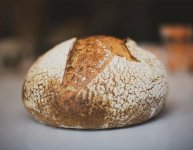Dawn
Culinary Explorer
A good snack

Making sourdough bread without a traditional sourdough starter is challenging because the starter provides the natural yeast and bacteria necessary for the fermentation process. However, you can create a sourdough-like bread using a shortcut method that mimics some aspects of sourdough flavor. Here’s a recipe that uses commercial yeast but incorporates yogurt to add a tangy flavor:
Ingredients:

Making sourdough bread without a traditional sourdough starter is challenging because the starter provides the natural yeast and bacteria necessary for the fermentation process. However, you can create a sourdough-like bread using a shortcut method that mimics some aspects of sourdough flavor. Here’s a recipe that uses commercial yeast but incorporates yogurt to add a tangy flavor:
Ingredients:
- 4 cups bread flour
- 1 ½ cups lukewarm water
- 1 cup plain yogurt (preferably full-fat)
- 2 teaspoons salt
- 2 teaspoons sugar
- 1 packet (7 grams) instant yeast
- Olive oil (for greasing)
- Mixing the Dough:
- In a large mixing bowl, combine the lukewarm water, yogurt, sugar, and instant yeast. Stir well to dissolve the yeast.
- Add Flour and Salt:
- Gradually add the bread flour and salt to the bowl. Stir until a shaggy dough forms.
- Kneading:
- Turn the dough out onto a lightly floured surface. Knead the dough for about 10-15 minutes until it becomes smooth and elastic. You can also use a stand mixer with a dough hook attachment for this step.
- First Rise:
- Place the dough in a lightly greased bowl and cover with a clean kitchen towel or plastic wrap. Let it rise in a warm, draft-free place for about 1.5 to 2 hours, or until doubled in size.
- Shaping the Loaf:
- Once the dough has risen, gently punch it down to release the air. Shape it into a loaf by folding the edges towards the center and then rolling it into a smooth ball or oval shape. Place the shaped loaf on a parchment-lined baking sheet.
- Second Rise:
- Cover the shaped loaf loosely with a kitchen towel and let it rise again for about 1 hour, or until it doubles in size.
- Preheat the Oven:
- About 30 minutes before baking, preheat your oven to 425°F (220°C). Place an empty baking dish or cast iron skillet on the bottom rack of the oven.
- Baking:
- Optionally, slash the top of the loaf with a sharp knife or razor blade to allow for expansion during baking. Place the baking sheet with the loaf in the preheated oven. Pour about 1 cup of hot water into the empty baking dish or skillet to create steam in the oven, which helps to develop a crusty exterior on the bread.
- Bake for about 25-30 minutes, or until the bread is golden brown and sounds hollow when tapped on the bottom. If you have a thermometer, the internal temperature should register around 200°F (93°C).
- Cooling:
- Transfer the bread to a wire rack and let it cool completely before slicing. This allows the crumb structure to set properly.
